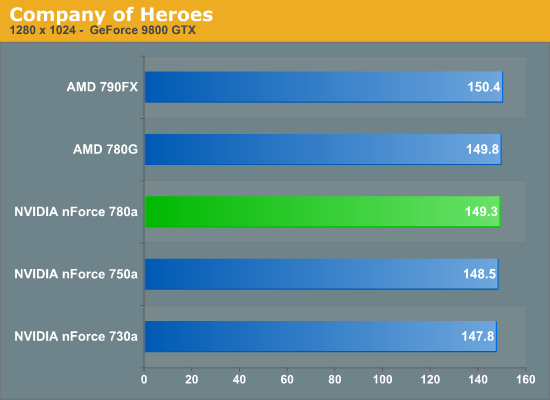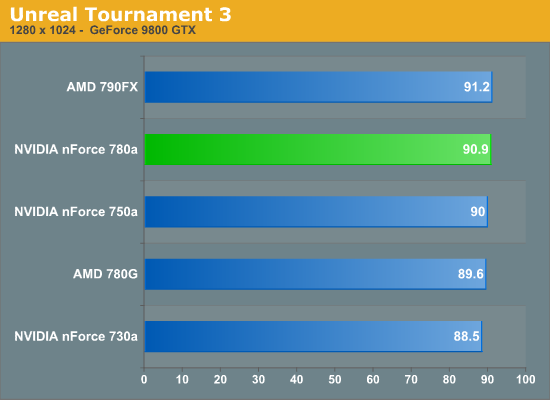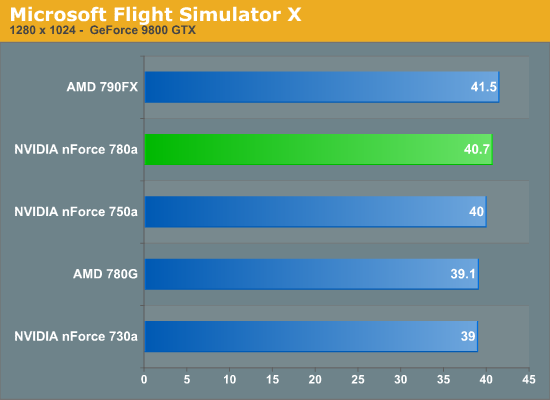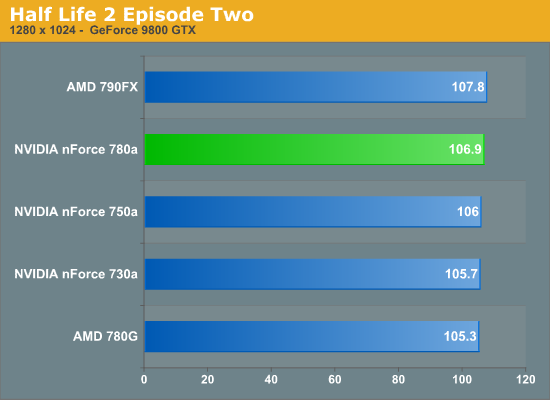NVIDIA 780a: Integrated Graphics and SLI in One
by Gary Key on May 6, 2008 12:00 AM EST- Posted in
- CPUs
Gaming Performance
As usual, we test gaming performance with a variety of current games. We run our benchmarks at 1280x1024 when utilizing the Zotac 9800GTX.
Company of Heroes
Despite having been around for a while, Company of Heroes is still one of the best strategy games available. The game is heavily GPU limited but also requires brute CPU processing power to keep things smooth during heavy action. The built-in benchmark is very responsive to GPU as well as CPU scaling, hence we think it provides good insight into overall system gaming power.

Crysis
Without doubt, Crysis is the sternest 3D test for any motherboard and GPU solution. The Crysis team reached new heights in developing a FPS engine that brings even the highest specification systems to their knees. Users have begun to base purchasing decisions solely on how well a component handles this game. As we are using a single card or IG solution here, we have to stick with medium or low detail levels. We utilize a custom demo that captures game play on the Harbor level.

Unreal Tournament 3
UT3 landed on our PC's hard drive a while ago and has not failed to deliver the ultra fast FPS shooter we all expected. The 3D engine provides ultra fast-paced action requiring a system capable of sustaining frame rates during periods of intense online gaming action. We play a three minute round of action with 11 bots on the CTF Coret level and generate an average FPS score based on five benchmark sessions.

Microsoft Flight Simulator X
One of the longest running titles on the PC, Flight Simulator is great game for people wanting to enjoy flight without all the hassles. Depending on how you configure FSX, you can have a CPU or GPU restricted setup. Our flight recording is based on a six minute flight around Honolulu in a Cessna 172 and we generate our benchmark results with FRAPS.

Half-Life 2: Episode 2
Half-Life 2: Episode 2 is our last title and it represents a game engine that is very scalable and works well on an IG board or one equipped with SLI or Crossfire. We utilize a custom demo that has indoor and outdoor action along with several firefights to ensure we stress the GPU.

Gaming Summary
Take your pick and be happy in knowing that at least with a discreet GPU installed, any of the boards are capable gaming platforms. The overall winner is the 790FX, but the differences in scores between each platform are minimal at best. Crysis and Flight Simulator X show a maximum difference of 6%, while most of the tested titles show less than a 3% difference.










38 Comments
View All Comments
homerdog - Tuesday, May 6, 2008 - link
Don't get me wrong, HybridPower is a cool feature that I will consider when I'm making my next motherboard/GPU purchase.However, the fact remains that the HD3K cards have a significantly larger delta between their idle and load power consumption figures than the current crop of Nvidia cards. If ATI continues to build on this trend they may not even need a complex mGPU/dGPU hybrid solution to get idle consumption down to near IGP levels, although they're probably working on one anyway.
JarredWalton - Tuesday, May 6, 2008 - link
Now we just need Hybrid Power in laptops - where it should have been first, IMO! At the very least, HybridPower should have shipped with support for 8800GT/GTS 512 and 9600 cards rather than just 9800 GTX/GX2.Also, my two cents on GeForce Boost: hooray for an extra 20% over 20FPS. That sounds fine, until you look at the bigger picture. A GeForce 8400 GS or 8500 GT is terribly slow relative to most discrete GPUs. Sure, they cost $40 to $70 depending on model and features. An extra 20% performance (or even 50%) would be fine. However, a $75 8600GT is already about twice as fast and a 9600GT (with rebates available for $110-$120) isn't even on the same continent.
If you have an IGP motherboard and you think it's too slow for games, I seriously doubt you're going to want to spend $50 to roughly double the performance. As any mathematician can tell you, multiplying any real number by zero is still zero. It may not be that bad, but I'd say 9600GT with Hybrid Power support is what people should shoot for. I figure that will arrive some time in the near future. Then just wait for it to show up on Intel platforms.
FITCamaro - Tuesday, May 6, 2008 - link
While I agree with you, I think this is a great idea. An onboard GPU is always going to use less power than a discrete one. The main issue I'm concerned with is, does the system get back the memory used by the onboard GPU when the discrete GPU is in use? Granted it's only going to use 64-128MB of RAM likely, maybe 256. But still, those are resources that aren't able to be used by games.Of course it doesn't really matter for most since it only supports the 9800GTX and 9800GX2 and, in my opinion, you'd have to be stupid to go with the 9800GTX when the 8800GTS 512MB offers nearly identical performance. Heck even the 8800GT 512MB is only about 5 FPS different.
They need to offer the hybrid power support across the entire 8x00 series.
BansheeX - Tuesday, May 6, 2008 - link
Who cares about the Phenom? Where is the Intel variant, aka 730i? Another three month delay for that one? Sigh.FITCamaro - Tuesday, May 6, 2008 - link
People who want a Phenom.DigitalFreak - Wednesday, May 7, 2008 - link
Those mythical people exist?KnightProdigy - Thursday, May 8, 2008 - link
There are a lot of AMD fans. AMD still has a lot of loyal followers, maybe you forget that AMD had the speed crown for many more years than Intel. I have been an NV fan since it was STB in the early 90s, I, for one, like the fact that they are offering similar solutions, even though they lag a little.Gary Key - Tuesday, May 6, 2008 - link
We expect to see the Intel mGPU variants this summer, just in time to compete with the G45.